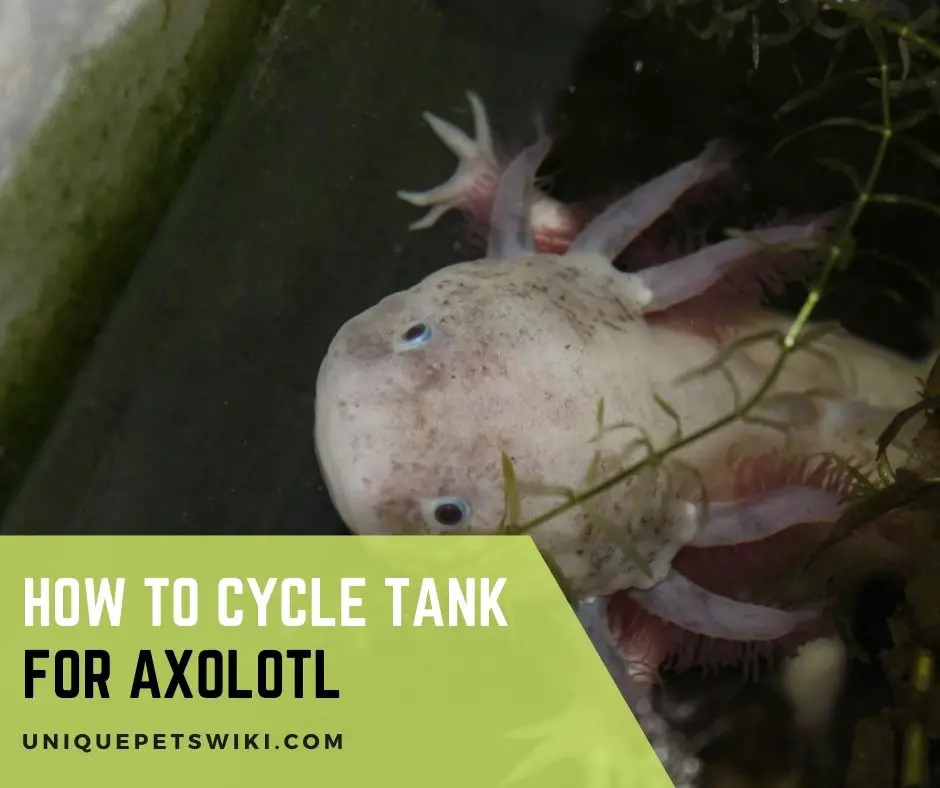One of the most important things you’ll do as an axolotl owner is to cycle your pet’s tank. Tank cycling helps increase beneficial bacteria in the tank, keeps the ammonia levels down, and helps your axolotl remain safe and healthy.
To explain simply: tank cycling breaks down the ammonia and nitrites into less harmful substances (nitrates) and also reduces other toxic build-ups from the tank water.
In this guide, we will break down the steps of how to cycle the tank for your axolotl. We will also cover some common issues you might face while cycling along with the ways to prevent them.
Contents
- What Is a Cycled Tank?
- What Do You Need to Cycle Tank For Axolotl
- How To Cycle Tank For Axolotl – 7 Steps
- Set Up Your Tank and Filter Before Starting The Cycling
- Adding a Cycling Kick-Start Bacteria
- Adding Ammonia to Feed Bacteria
- Maintain Ammonia Levels at 2-3ppm and Test the Ammonia and Nitrite Levels
- Continue Maintaining Ammonia Level At 2-3 ppm And Test Water Parameters Daily
- Change 70% Water to Bring Nitrates Down
- Put The Axolotl In
- 9 Common Problems When Cycling an Axolotl Tank
- pH Is Lower Than 7.4 -7.6
- Nitrate Gets Too High and Water’s pH Goes Down
- pH Is Higher Than 7.4 -7.6
- Ammonia is Higher Than 0 Ppm
- Ammonia is 0 Ppm At the Beginning of The Cycle
- Nitrite/Nitrate Are Above 0 ppm
- Ammonia Not Being Converted Into Nitrites
- Having Nitrites, But No Nitrates
- High Ammonia and Possibly Some Nitrites
- What Are the Ideal Water Parameters for My Axolotl?
- What Happens if You Don’t Cycle Your Aquarium?
- Wrapping Up – How To Cycle Tank For Axolotl
What Is a Cycled Tank?
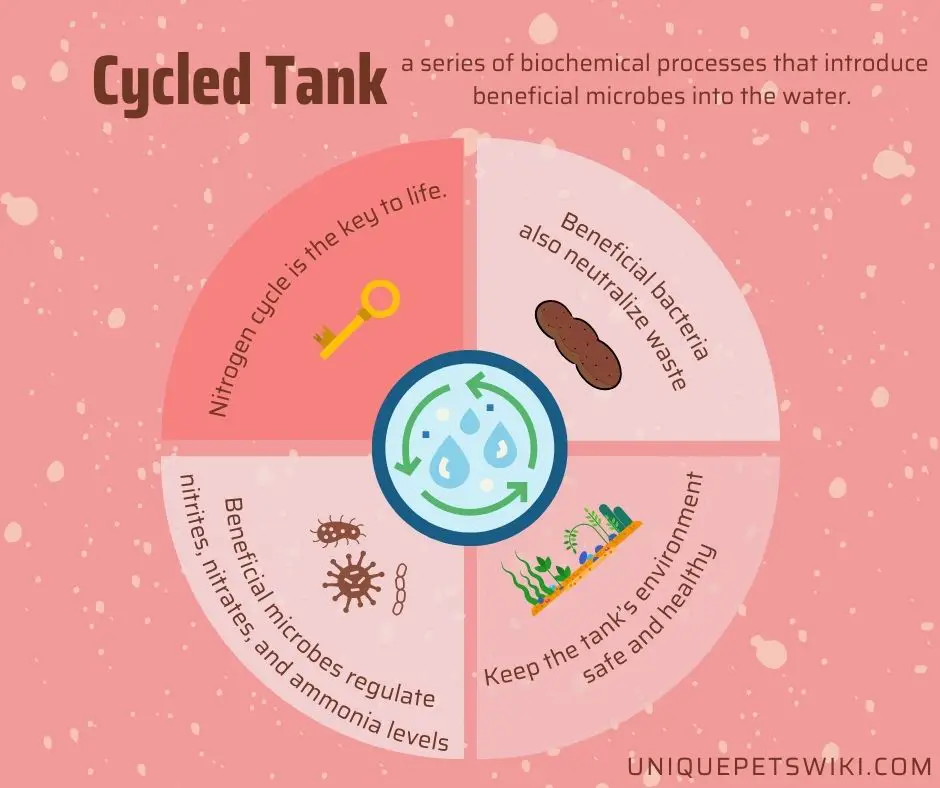
Axolotls in the wild are found in the five great lakes of Mexico, mainly Lake Xochimilco.
In their natural habitat, a nitrogen cycle occurs continuously without the need for direct human intervention thanks to the bacteria present in the lake water.
This nitrogen cycle is the key to life. It consists of a series of biochemical processes that introduce beneficial microbes into the water.
These beneficial microbes, in turn, regulate the nitrites, nitrates, and ammonia levels in the water.
Keeping these parameters (ammonia, nitrates, and nitrites) at a safe level is very important for your axolotl’s health and well-being.
In captivity, you need to cycle the aquarium tank water to introduce beneficial microbes and help with the nitrogen cycle.
This is important to keep the water parameters at an optimum level for your pet. Beneficial bacteria also neutralize axolotl’s waste and keep the tank’s environment safe and healthy for your Axie.
Here is how the cycle works:
- Like any living organism, your axolotl will produce waste after assimilating its food.
- A major component of the waste is ammonia. High levels of ammonia are harmful to your axolotl and could cause cell and neurological damage. It could even kill your axolotl.
- Thankfully, beneficial bacteria or microbes in the tank break down this ammonia into nitrites and another group of beneficial microbes converts the nitrites into nitrates. Nitrate, the final product of this cycle, is a lot less toxic to axolotls.
Can You Cycle a Tank With an Axolotl In It?
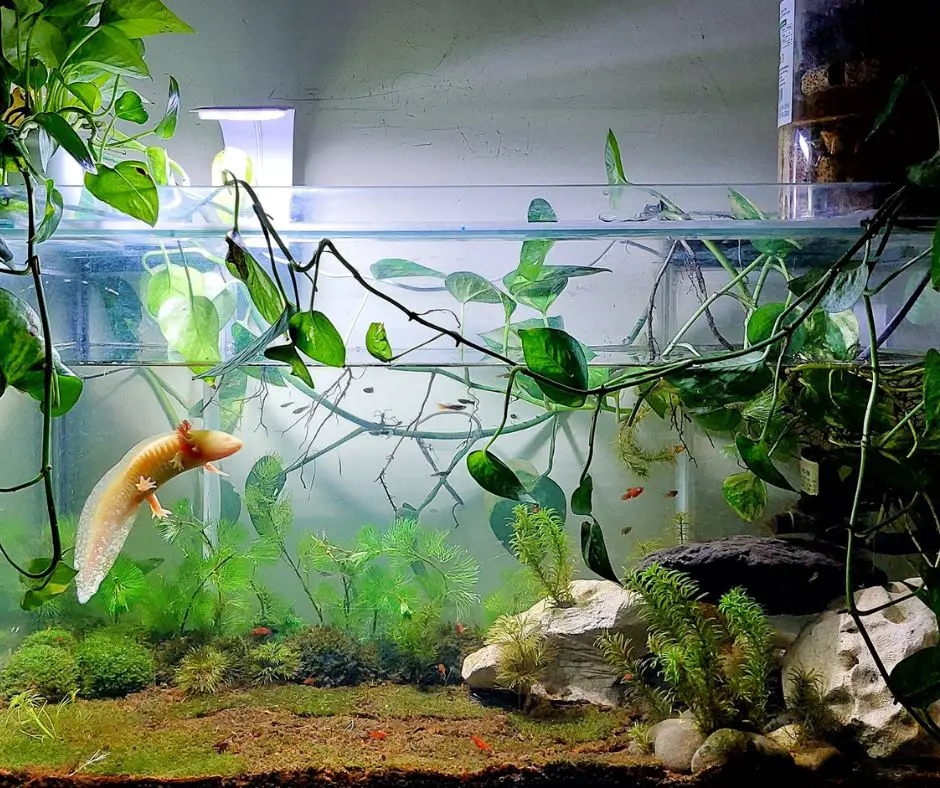
Ideally, you should not cycle a tank with the axolotl inside as the high levels of nitrites and ammonia could do irreversible damage to your pet and might even kill it.
When you first buy your axolotl, carefully follow the instructions provided by the seller/breeder regarding cycling. They will tell you whether your tank needs cycling as well as the methods for doing it.
Cycling of a brand new tank can take anywhere between 4 and 8 weeks. During this period, you could add some hardy fish into the tank but not delicate fish or axolotls.
As explained earlier, the dangerous levels of ammonia and nitrites could kill your pets.
The nitrogen cycle consists of three different stages so you also need to test your water for ammonia, nitrites, and nitrates from time to time. It is best to keep your axolotl in another cycled tank while its main tank is being cycled.
Some hardy fish can live in the tank while it is being cycled. However, it is essential to note the fact that adding fish does not speed up the cycling process and could even harm them.
In fact, many aquarium keepers believe that the addition of fish/axolotls during initial cycling is a cruel practice that is best avoided.
How Long Does it Take To Cycle An Axolotl Tank?
This process of cycling can take between 4 and 8 weeks. This period is crucial as it helps add beneficial bacteria to support the tank’s inhabitants.
The nitrogen cycle of a tank can only begin after you have some ammonia in the water.
This is why you need to keep testing the water for the three parameters and must not add your axolotl until they are at a safe level. The levels of ammonia and nitrate maybe still too high and could kill the pet/s.
Both ammonia and nitrites should be completely undetectable before you can add your axolotl to the tank.
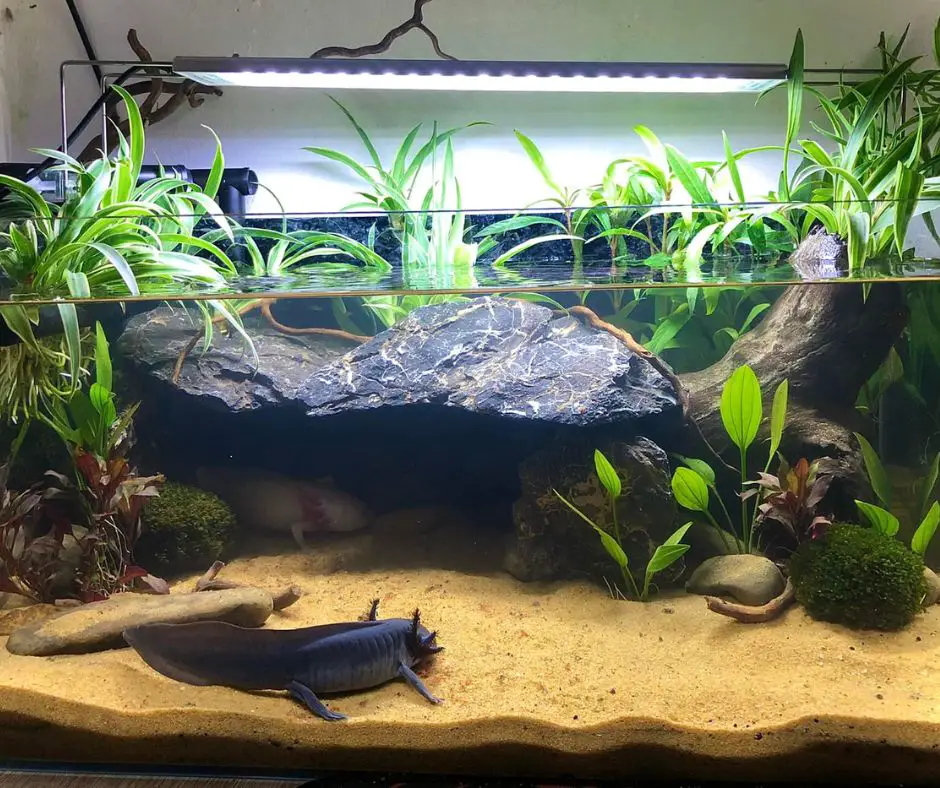
What Do You Need to Cycle Tank For Axolotl
- You need an appropriately sized tank with a filter.
- You also need some live plants because their falling leaves can aid ammonia production. Make sure you thoroughly rinse the plants first before introducing them in the tank.
- You can also add aquarium plant fertilizer along with some substrate for the plants. A moderate level of substrate will hold the plants and decorations in place. Aquarium plant fertilizers are needed to provide iron, sulfur, phosphorus, carbon, magnesium, and potassium to the plants.
- Place some decorations like hideouts, pipes, or hollow rocks in the tank. Add in some driftwood. Make sure it is clean and unprocessed. You can also add in decorations from a cycled tank so they have some beneficial bacteria on them.
- Fill half the tank with dechlorinated water. Once all the plants and decorations are in place, fill up the rest of the tank with dechlorinated water.
- Add beneficial bacteria along with fish food flakes to provide ammonia. This will start the tank’s nitrogen cycle. Avoid adding your axolotl in the tank at this point as they could disturb the cycle and could even get killed due to the higher levels of ammonia.
- For the first two to three weeks of the water cycling, keep testing the water regularly using aquarium water test kits.
- You can then switch to testing once or twice a week for a total period of 8 weeks. Only add the axolotls to the tank once its ammonia and nitrates have both fallen to zero.
Aquarium Test Strips for Fish Tank 9 in 1
- 9-IN-1: Keep your aquarium clean and your fish healthy with our 6-in-1 fish tank water testing kit. Test your aquarium water for hardness, carbonate chlorine, nitrite, free chlorine, pH, nitrate, alkalinity, iron, and copper
- QUICK & EASY: Our water test kits for aquariums take the guesswork out of your aquarium maintenance. Simply dip the aquarium pH test strips into the water to get your results within seconds and adjust your water accordingly
- ACCURATE & RELIABLE: The aquarium pH test kit bottle features a comprehensive color chart for reliable and accurate results. It’s never been this easy to take a faultless reading of your test strips for fish tank maintenance
- 100 TEST STRIPS: Our aquarium test kits include 100 aquarium pH strips for freshwater and saltwater. The fish tank care kit can be used to monitor the water conditioning of fish bowls, fish tanks, ponds and aquariums
- INCLUDES EBOOK: The fish tank test kit comes with our eBook, exclusive to JNW Direct customers, that walks you through the meaning of different test results and explains how to achieve a healthy aquarium environment
Last update on 2022-12-29 / Affiliate links / Images from Amazon Product Advertising API
We further simplify this process in the section below.
How To Cycle Tank For Axolotl – 7 Steps
Cycling the axolotl’s tank is the most important thing you can do to keep your pet healthy and safe. Here are the 7 steps for cycling the axolotl tank:
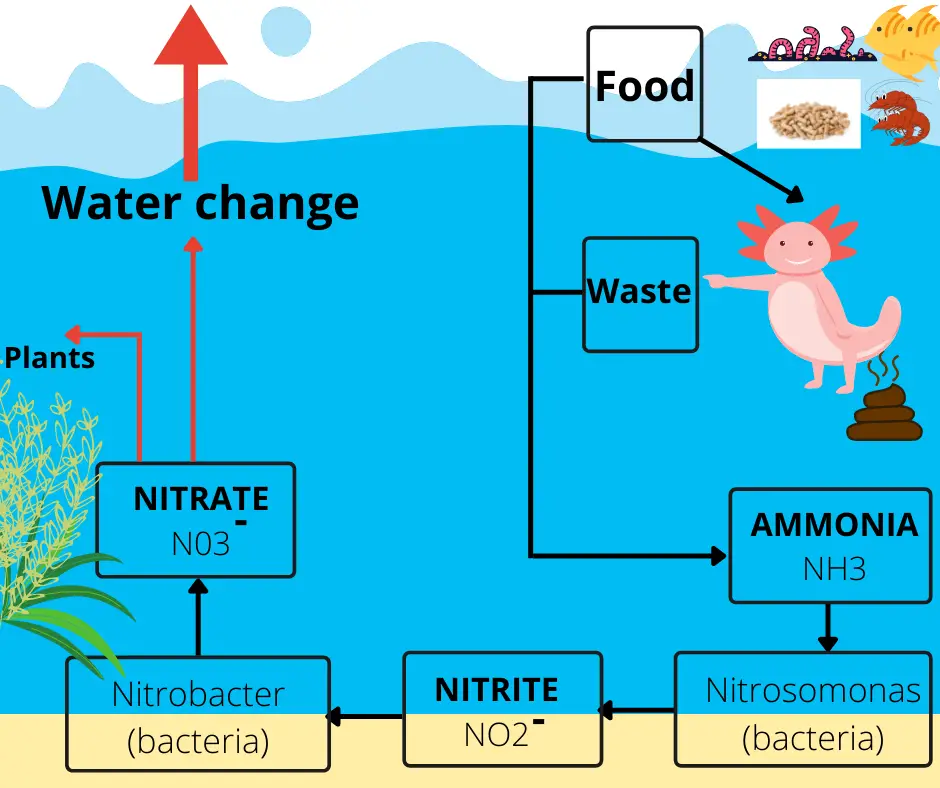
Set Up Your Tank and Filter Before Starting The Cycling
A tank of appropriate size is important for your axolotl’s comfort. Choose at least a 20-gallon tank size for one axolotl.
For two or more axolotls, choose a tank that is at least 50-75 gallons in size. Wash the tank with plain tap water. Do not use any soap or detergent as the residue could harm the inhabitants of the tank.
Place the tank in a dark area away from direct sunlight. You can add in a filter, bubbler, or air stone.
Adding a Cycling Kick-Start Bacteria
You can buy certain nitrogen cycle-kickstarting bacteria that help start the nitrification in tanks.
Products like this one contain live non-pathogenic bacteria that are known to rapidly kickstart the filtration process and enhance the rate of nitrification in tanks.
Tank Starting Bacteria Culture for Biological Filtration
- Concentrated 15X Suspension of LIVE non-pathogenic microbes, specifically formulated to extremely rapidly establish biological filtration in new aquarium set-ups, and to enhance the rate of nitrification in existing systems.
- Useful for rapidly re-establishing nitrification bacteria in case of an emergency
- Particularly useful in aquaria with high population densities and when adding new fish. Supplied in a proprietary base which provides for maximum longevity.
- Helpful to re-establish nitrifying bacteria after cleaning rocks and surfaces and after use of medications. 1. Rapid reduction of ammonia, and nitrite. 2. Prevents “New Tank Syndrome.”
- Takes 5-7 days to cycle.
Last update on 2022-12-30 / Affiliate links / Images from Amazon Product Advertising API
Adding Ammonia to Feed Bacteria
There are numerous ways to add ammonia to feed the beneficial bacteria which convert the ammonia into nitrites.
- Ammonia can come from uneaten fish food, axolotl’s poop, and dead plants. You can buy some fish flakes from the pet shop and allow them to sink to the bottom of the tank. As they rot, they will produce ammonia.
- Alternatively, add 2-3ppm of ammonia chloride solution to the tank water. We recommend Dr. Tim’s ammonium chloride solution which is specially made for fishless cycling.
- You can also use fish waste as an ammonia source. Some people add hardy fish like guppies or hardy danios to the tank. Their waste helps produce ammonia. Do not add too many fish all at once while your tank is new. Slowly add in fish as the tank cycles.
- Continue using the API test kit to test Ammonia. At this point, the ammonia levels will be typically high – 2-3 ppm. The water will also be cloudy. Worry not, it will begin to clear slowly. Also, in the beginning, the nitrite and nitrate levels will be 0.
API TEST KIT
- For fresh and Saltwater
- Monitor ammonia levels
- Helps prevent Fish loss
Last update on 2022-12-29 / Affiliate links / Images from Amazon Product Advertising API
Maintain Ammonia Levels at 2-3ppm and Test the Ammonia and Nitrite Levels
- Test the ammonia levels every 3 days or so to see if ammonia has gone down. If it has, then the nitrogen cycle is working.
- After a week, you can start testing for nitrites.
- Once ammonia decreases you can move on to testing the nitrite levels.
- The presence of nitrites indicates that the first colony of nitrifying bacteria has developed and converted some ammonia to nitrites. Test the result of this step with the API test kit will show a decrease in the levels of ammonia and an increase in nitrites. However, Nitrates should still be 0.
Continue Maintaining Ammonia Level At 2-3 ppm And Test Water Parameters Daily
- Continue to add Dr. Tim’s ammonium chloride solution every day.
- Test all 3 Parameters
- Once ammonia and nitrites become 0, it means that your tank is cycled
The result of the ‘ideal tank cycled stage’ is 0 ammonia, 0 Nitrites, and an increase in Nitrates to <40ppm.
Change 70% Water to Bring Nitrates Down
If nitrates are over 40 ppm, consider changing 70% of the water. This will help you keep the nitrate levels down. Water changes also help replace the electrolytes in the tank and remove dissolved organic compounds in the water that impact its quality.
Test the water again. It is best not to add your axolotl at this point as the nitrite and nitrate levels maybe still too high.
Put The Axolotl In
After about 6-8 weeks from the time you began the tank’s cycling with beneficial bacteria, you can change around 25% of its water.
This will further lower the nitrate levels to between 15 and 40 ppm. You can add the axolotl at this point – but only after testing the ammonia, nitrite, and nitrate.
DrTim’s Aquatics Ammonium Chloride Solution for Fishless Cycling
- FISHLESS CYCLING AQUARIUM CLEANING TREATMENT: The ammonium chloride solution from DrTim’s Aquatics offers a chlorine-free method for sanitizing new aquaria or when cycling water when fish or coral are not present. This powerful solution makes fishless cycling mess free.
- REMOVES HARMFUL TOXINS FROM SALTWATER FISH TANKS: Even with regular water changes and maintenance, aquariums and fish tanks produces bad bacteria and it can take up to 30 days to eliminate waste. When using this ammonium chloride solution for fishless cycling with DrTim’s Aquatics One & Only, you can instantly create a bio filter to remove nitrite and toxic ammonia naturally.
- 100% NATURAL, ECO-FRIENDLY FISH TANK CLEANER: There’s no need to wait when treating your new saltwater aquarium or freshwater fish tank with this ammonium chloride solution and One & Only from DrTim’s Aquatics. This fish tank cleaner eliminates new tank syndrome and does not include sulfur or other offensive odors.
- AQUARIUM SUPPLIES YOU NEED: Offer your pet fish and corals an environment in which they can thrive with this ammonium chloride solution that cleans with just four drops per gallon. Ammonium chloride from DrTim’s Aquatics is available in 2 and 4 ounce sizes.
- HIGH-QUALITY AQUARIUM PRODUCTS: DrTim’s Aquatics offers an expansive line of aquarium products used by professionals and residential customers. Based on years of experience in marine biology, DrTim’s Aquatics’ products utilize his vast knowledge and are backed by scientific evidence and innovative research.
Last update on 2022-12-30 / Affiliate links / Images from Amazon Product Advertising API
9 Common Problems When Cycling an Axolotl Tank
In addition to maintaining the three parameters, many axolotl owners run into problems when cycling their tanks. This includes pH imbalances, higher than desired nitrates, and an increase in ammonia while balancing the nitrates.
Let us take a look at ways to solve these common issues.
pH Is Lower Than 7.4 -7.6
- The ideal pH for an axolotl tank is between 7.4 and 7.6. This level of pH helps maintain the nitrogen cycle. If it falls below 6.4, the water becomes acidic and that could slow down the rate at which ammonia is converted to nitrite. This can stall the Nitrogen Cycle in the water and negate all your efforts.
- If the pH is consistently below 6.4, you need to add some crushed coral or limestone. Place them in an aquarium-safe mesh bag or inside the water filter and add them in the tank. This will balance the water pH.
Nitrate Gets Too High and Water’s pH Goes Down
- If this happens, you need to make a 50% water change in the tank to reduce the nitrate levels in the water. Using a bit of RO (reverse osmosis) or deionized water can help bring the pH up slightly.
- The safest way to increase pH to between 7.4 and 7.6 is by adding crushed coral, dolomite, or decorating your aquarium with limestone.
pH Is Higher Than 7.4 -7.6
- If the pH is higher than 7.4 – 7.6, you need to add some untreated, natural driftwood to your tank.
- Peat moss and capata leaves are also a safe and natural way to balance those high pH levels and bring them back to neutral.
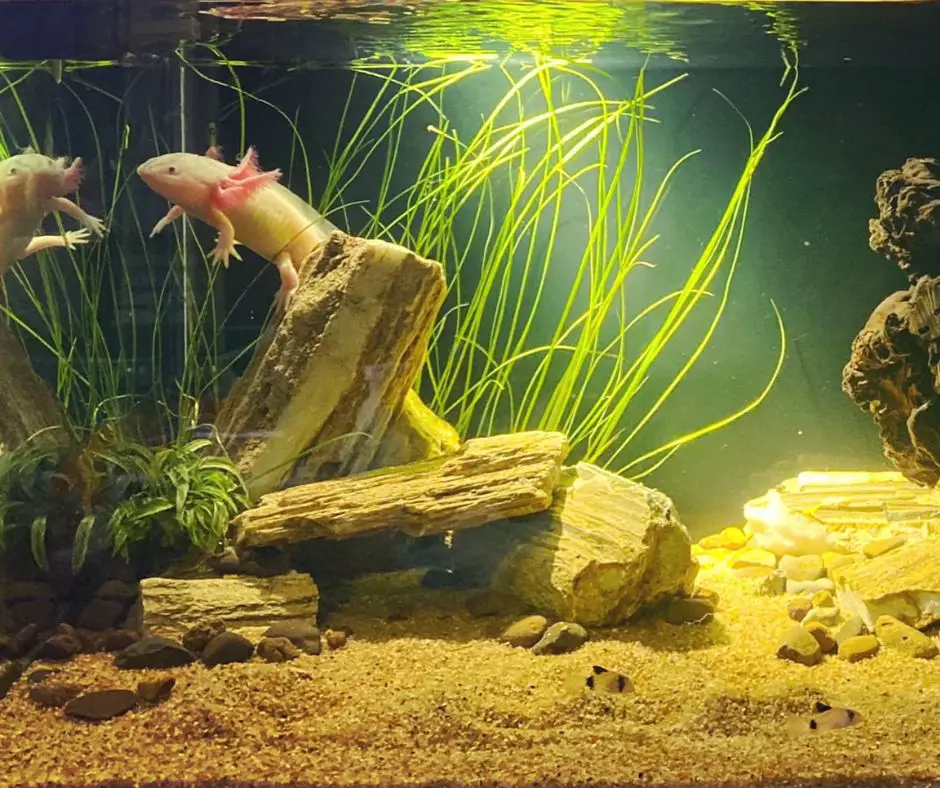
Ammonia is Higher Than 0 Ppm
If at the end of cycling, the ammonia levels are still higher than 0ppm, then it is still unsafe to add in your axolotl. Use the following ways to reduce ammonia in the tank:
- Make a partial water change. Remove 50% of tank water and replace it with an equal quantity of dechlorinated water.
- Use a water filter. For a 20-gallon tank, a hang-on-the-back water filter like this one is adequate. For larger tanks, you can use two filters. If your existing water filter seems clogged, clean it.
Fluval C Series Power Filter, Clip-On Aquarium Filter
- 5-stage clip-on power filter designed for freshwater and saltwater aquariums between 40 and 70 gallons
- Two mechanical stages trap large and fine debris, foams easily slide out for quick cleaning
- Chemical stage with activated carbon effectively removes toxins
- Biological stage features Bio-Screen pad, blocks debris and provides massive surface area for beneficial biological activity
- Biological Trickle Chamber super charged for fast and efficient nitrification when loaded with Fluval C-Nodes
Last update on 2022-12-30 / Affiliate links / Images from Amazon Product Advertising API
- Remove uneaten fish food from the water. If needed, vacuum or siphon the substrate to remove fallen leaves and dead plants that generate ammonia.
- Lower the pH of the water. This will not eliminate ammonia, but it is safer for your axolotl. Add some natural untreated driftwood which releases tannins making the water slightly acidic.
Ammonia is 0 Ppm At the Beginning of The Cycle
If at the beginning of the cycle, the ammonia levels are 0 ppm, it means that you didn’t add enough ammonia. Try adding some fish food, live plants, or hardy fish like guppies to produce more waste in the tank.
Nitrite/Nitrate Are Above 0 ppm
- A 30-50% water change should do the trick for this issue. But do make sure that the water source you are using itself does not contain nitrates.
- An aquarium water conditioner is like a “nitrite remover in a bottle”. Products like this one quickly start the nitrogen cycle and speed up the cycling process.
API AQUARIUM START UP PACK Water Conditioner
- Contains one (1) API AQUARIUM START UP PACK Water Conditioner 1.25-Ounce Bottle 2-Pack
- Makes tap water safe for fish and reduces fish stress.
- Starts aquarium cycle and allows instant addition of fish.
- Comes with two API products, STRESS COAT and QUICK START, for a healthy start-up aquarium.
- Use when starting a new aquarium, changing water, or adding fish. Add STRESS COAT first and then QUICK START.
Last update on 2022-12-30 / Affiliate links / Images from Amazon Product Advertising API
Ammonia Not Being Converted Into Nitrites
If during the middle of the cycling period, you find that the ammonia levels are still high and nitrites are very low, then it is an indication that you don’t have enough nitrifying bacteria in the tank.
There are a couple of ways to rectify this:
- Consider adding in more bottled bacteria. This will convert the ammonia into nitrites.
- Also, ensure that your filter is running constantly.
Having Nitrites, But No Nitrates
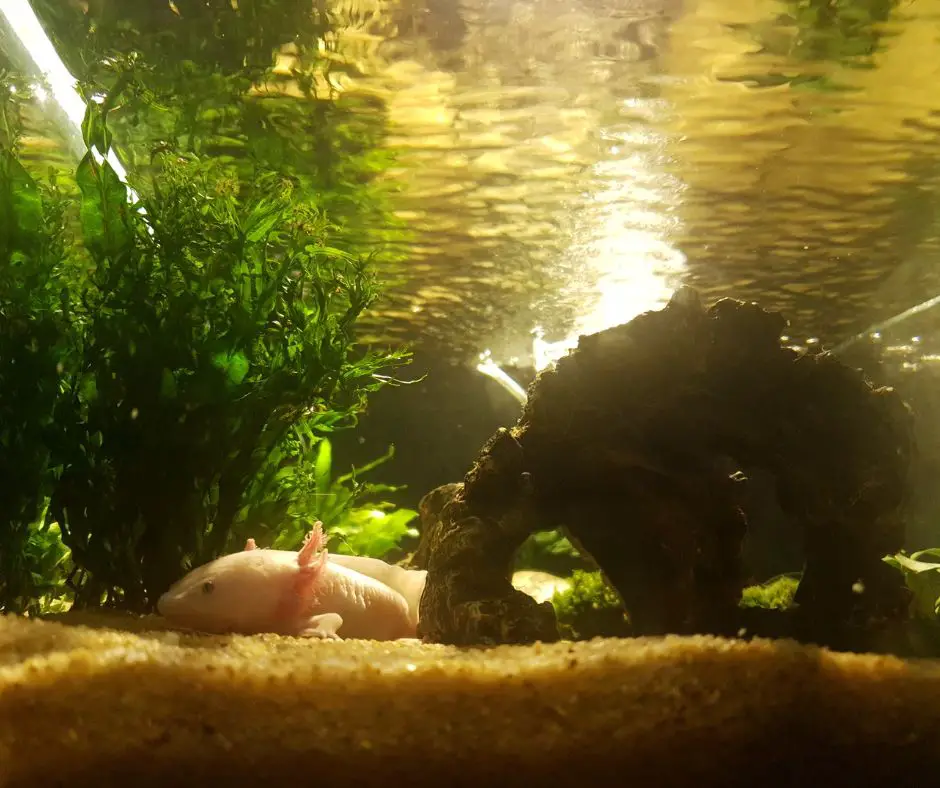
Higher levels of nitrites without any nitrates mean that your tank is extremely clean, or its nitrogen cycle has ‘crashed’ or your cycling isn’t moving forward.
It could also be an indication that the bacteria that convert nitrite to nitrates are not available in sufficient numbers.
- You would need to make a water change (about 20-30%) so that levels or nitrites drop to 1-3ppm.
- Add some more beneficial bacteria available in a bottle.
- Consider testing the water again – sometimes, the test strip could be faulty.
High Ammonia and Possibly Some Nitrites
This is an indication that the bacteria that convert nitrites to nitrates are insufficient. The ways to rectify this are as follows:
- Change about 30-50% water, but do ensure that you only use dechlorinated water.
- Make sure your filter is running. Check the filter – if the flow is impacted, consider replacing/cleaning it.
- Add some more bottled bacteria to the water.
What Are the Ideal Water Parameters for My Axolotl?
Axolotls prefer water pH between 7.4 and 7.6 although a value between 6.5 and 8 is also acceptable. They also like cooler water, so maintain its temperature between 16-18 C or 60-64 F.
Nitrates are the ‘end state’ of the nitrogen cycle. They are not toxic to axolotls and their level can be up to 40 ppm. Nitrites and ammonia are toxic to axolotls so they should be 0 ppm.
What Happens if You Don’t Cycle Your Aquarium?
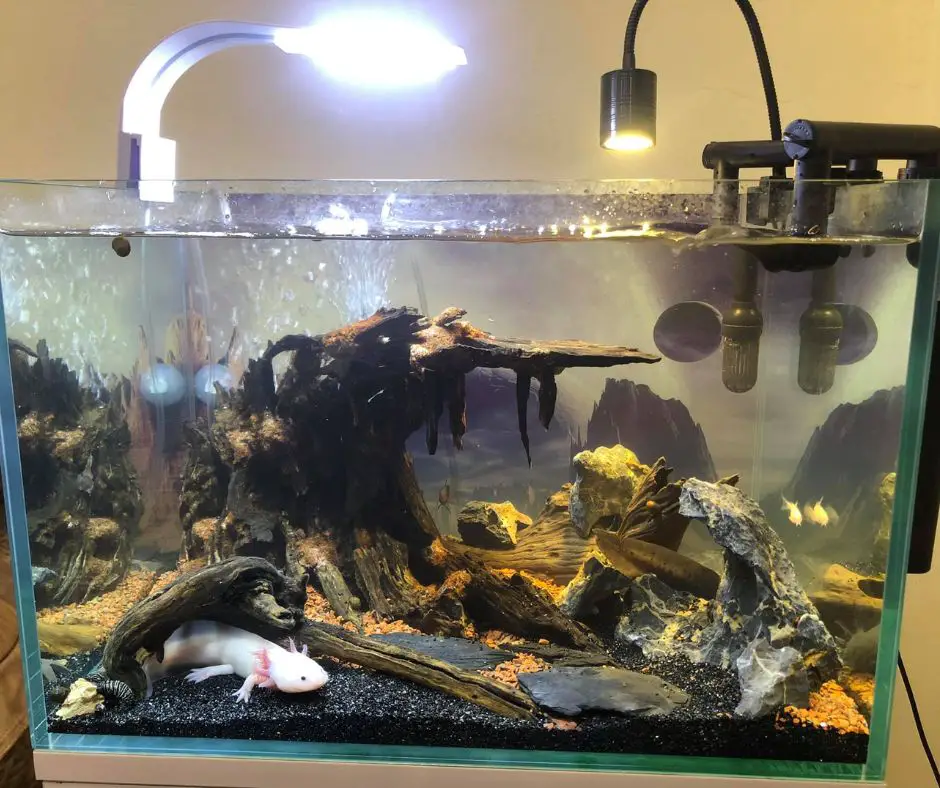
If you do not cycle your aquarium, the ammonia will build up to toxic levels. This could damage your axolotls’ cells and even cause neurological damage. Over time, your axolotl could die.
This is why every tank must be cycled before you add your axolotls in it for the first time. After its three parameters are ideal, you can add the axolotl. On a weekly basis, make water changes of up to 70-80%.
This will reduce ammonia and nitrites further. From time to time, test the water parameters and make adjustments as needed.
Wrapping Up – How To Cycle Tank For Axolotl
Cycling your axolotl tank is an important step to reduce ammonia levels in the water. In the beginning, when you first set up your Axie’s tank, cycling is the most important part of the setup.
Later, after you add the axolotl to a properly cycled tank, you must continue making regular water changes or use a filter to reduce the ammonia and nitrites generated through your pet’s waste.
We hope this guide gives you all the clarity you need about this important process.
